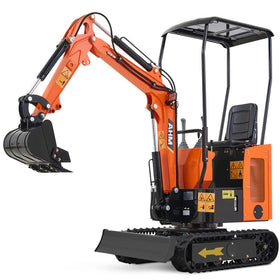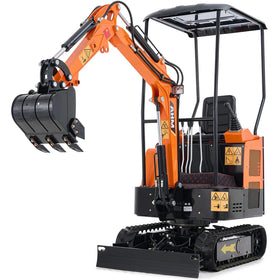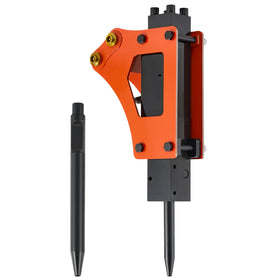Mini excavator power issues typically stem from 3 main sources:
- Not Enough Engine Horsepower - Many compact excavators in the 1.5-2 ton range come with just 15-17 HP engines, which can be insufficient for demanding applications
- Hydraulic System Problems - Restrictions, leaks, or component wear in the hydraulic system
- Maintenance Issues - Neglected service points that reduce overall performance
Nearly 54% of mini excavator performance complaints come down to insufficient power rather than mechanical failures. Understanding these warning signs helps you determine whether your machine needs maintenance or if it's simply undersized for your jobs.
Sign #1: Your Machine Struggles with Normal Soil

You're digging into moderately compact soil, the kind your machine should handle easily, but instead of cutting through, your bucket teeth just skim the surface. After several attempts, you're barely making progress.
This is the most obvious sign you're dealing with a power shortage. You'll notice:
- Your bucket bounces off rather than digging into harder layers
- You need multiple passes to reach your target depth
- You've started using a smaller bucket just to maintain some productivity
According to contractors we've worked with, this power deficiency can slash your productivity by 30-40% compared to properly powered equipment. That directly impacts your timeline and your profit margin.
"We wasted three weeks thinking our machine needed fixing. Turned out our 15 HP just couldn't handle the clay on foundation jobs. Should've upgraded sooner instead of throwing money at repairs." - Jim Carson, Carson Construction
Sign #2: Slower Hydraulic Function Response

You move the joystick, but there's that frustrating half-second (or longer) delay before anything happens. By the time the machine responds, you've already overcompensated and now you're making constant adjustments.
This lag is a telltale sign of insufficient power. You'll notice:
- A delay between joystick movement and actual cylinder activation
- Your bucket curl feels sluggish, especially when loaded
- Boom and arm movements start slowly before "catching up"
- Inconsistent speed that makes precision work difficult
Here's a simple test: Time how long it takes from full joystick movement to full hydraulic extension. In properly powered excavators, this should happen almost instantly (under 0.5 seconds). If you're regularly seeing delays of 1-2 seconds or longer, you're dealing with a power problem.
Sign #3: Inability to Multi-Task Hydraulic Functions
 On a properly powered mini excavator, you should be able to swing while lifting or travel while operating attachments. When these combined movements cause your machine to slow to a crawl, you're experiencing a power deficit.
On a properly powered mini excavator, you should be able to swing while lifting or travel while operating attachments. When these combined movements cause your machine to slow to a crawl, you're experiencing a power deficit.
You'll recognize this issue when:
- Your machine dramatically slows down when trying to swing while lifting
- You need to complete operations one at a time rather than simultaneously
- Different hydraulic functions seem to "fight" each other for available power
This limitation is annoying and expensive. Inability to effectively multi-task hydraulic functions can reduce operational efficiency by up to 45%. This dramatically affects cycle times and overall project costs.
Hydraulic Multi-Tasking Performance Comparison
|
Operation Type |
Sufficient Power |
Insufficient Power |
Productivity Impact |
|
Dig + Swing |
Smooth, full-speed |
Jerky, reduced speed |
-25% |
|
Lift + Travel |
Consistent performance |
Significant slowdown |
-35% |
|
Boom + Bucket + Swing |
Normal operation |
Nearly impossible |
-45% |
|
Attachment + Any Function |
Full capability |
Severe limitations |
-40% |
Sign #4: You're Burning More Fuel Than You Should
Here's something counterintuitive - an underpowered excavator often uses more fuel than a properly sized one. Because your engine is constantly running at higher RPMs, working harder to accomplish basic tasks.
You might notice:
- You're refueling more frequently for the same amount of work
- Your engine consistently runs at high RPMs
- Operating temperature stays higher than normal
Equipment operators report 15-25% higher fuel costs when using underpowered mini excavators. For a machine that runs 1,000 hours annually, that translates to hundreds or even thousands in wasted fuel costs.
Sign #5: Your Machine Overheats During Normal Work

When your mini excavator regularly runs hot during standard operations, it's telling you something important: you're pushing it beyond its capabilities.
Look for these warning signs:
- Hydraulic oil temperature frequently exceeds manufacturer recommendations
- You need cool-down periods during what should be normal work
- Warning lights or temperature alarms activate during standard operations
This isn't just an inconvenience - it's shortening your machine's life. Equipment regularly operated beyond its power capacity shows a 30-50% reduction in component lifespan, dramatically increasing your repair costs and downtime.
Getting Your Excavator Back on Track
3 Quick Fixes You Can Try Today
1. Hydraulic System Maintenance:
- Replace those hydraulic filters
- Make sure you're using the right hydraulic oil
- Check for and repair any leaks
- Verify your hydraulic oil is at the proper level
2. Engine Tune-Up:
- Complete a full engine maintenance check
- Replace air and fuel filters
- Look for fuel delivery issues
- Ensure your cooling system works properly
3. Adjusting Your Operation:
- Try using a smaller bucket for challenging materials
- Slow down your operating speed to maintain efficiency
- Perform functions one at a time rather than simultaneously
Long-Term Solutions When Maintenance Isn't Enough
If you've addressed maintenance issues but still face power problems, consider these options:
Hydraulic System Upgrades:
- Higher-efficiency pumps and motors
- Optimized control valves
- Improved cooling systems
Equipment Matching:
- Reassess what your typical jobs actually require
- Consider the soil conditions you normally work in
- Match your equipment specifications to these real-world demands
When It’s Time to Upgrade Your Mini Excavator

If your mini excavator consistently shows multiple power deficiency signs despite proper maintenance, it might be time to consider upgrading to a more powerful machine like a 2-ton mini excavator.
When you're ready to upgrade, here's what actually matters:
- More Horsepower: Look for at least 20 HP instead of the standard 15-17 HP in 2 ton excavators. This extra power makes all the difference when digging through tough clay or rocky soil.
- Better Hydraulics: Check the specs for "hydraulic flow rate" - higher numbers mean faster operation and better multitasking. It's like upgrading from a garden hose to a fire hose.
- Tougher Engine: Commercial-grade engines last longer under stress. They're built to run all day without overheating, unlike lighter-duty models that need frequent breaks.
- Serious Cooling System: Better machines have larger radiators and cooling systems that keep everything running at the right temperature, even during an 8-hour workday in summer heat.
- Better Value Over Time: A $5,000 price difference might seem huge upfront, but spread that cost over thousands of operating hours, and factor in the extra jobs you'll complete on time - the math usually favors the stronger machine.
FAQ: Mini Excavator Power Problems
1. Can adding aftermarket hydraulic components improve mini excavator power?
While certain aftermarket components can marginally improve performance, they cannot overcome fundamental limitations in engine horsepower. Most significant power improvements require upgrading to a machine with a more powerful base engine.
2. How do I determine if my mini excavator is underpowered or just needs maintenance?
If basic maintenance procedures like changing filters, replacing hydraulic oil, and tuning the engine don't resolve performance issues, you're likely dealing with an underpowered machine rather than a maintenance problem.
3. What horsepower rating is ideal for challenging soil conditions?
For challenging applications involving clay, rocky soil, or heavy lifting, mini excavators with at least 20-25 HP provide the necessary power reserve. Standard 15-17 HP machines often struggle in these conditions regardless of maintenance status.
4. Will operating an underpowered excavator damage it?
Yes, consistently pushing an underpowered excavator beyond its capabilities accelerates wear on the engine, hydraulic components, and structural elements. This results in more frequent breakdowns and shorter overall machine lifespan.
5. How significant is the productivity difference between standard and high-powered mini excavators?
You'll have 30-50% productivity improvements when switching from standard 15-17 HP mini excavators to 25 HP excavator, particularly in challenging soil conditions or when performing multiple functions simultaneously.
Conclusion

The cheapest machine to buy is rarely the most economical to operate. Matching your equipment's capabilities to your actual job requirements is the surest path to profitability.
For contractors regularly working with challenging soil conditions or requiring maximum productivity, investing in a higher-powered mini excavator with 25+ HP (typically found in the 2.5-ton excavator) usually provides the best return through increased productivity, reduced fuel consumption, and longer component life.







